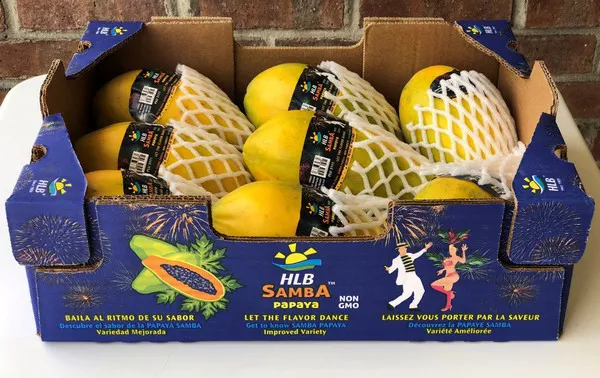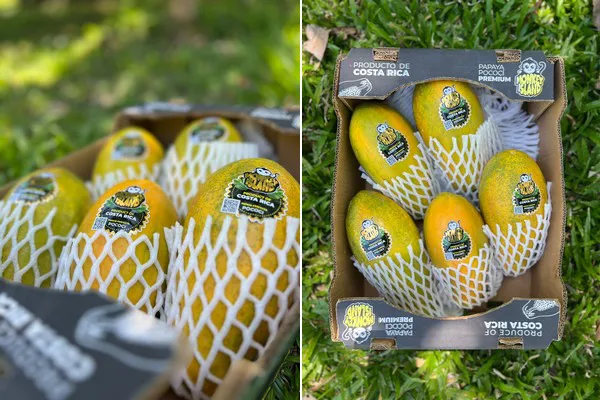For more than 30 years, HLB Tropical Food GmbH has been marketing papayas, introducing them to customers in the US and Europe. “Before HLB, papayas in Europe mainly came in by boat, green, and without much taste,” says Lorenz Hartmann de Barros with HLB Tropical. “Then, in the 1990s, we began shipping the small tree-ripened Sunrise papayas with color, by air. Initially, the market was apprehensive of ripe fruit. People tend to fear trying something new, so we offered a ripe pallet with color. The next day, the customer called and said he needed more, as he had never sold a pallet that fast.” HLB was also the first company that brought the large Formosa by air on a commercial level back in the 1990s and since then, several new varieties have been introduced.
One of these introductions was the Golden papaya about 20+ years ago. They were similar to the Sunrise variety, albeit without freckles and a very clean skin. The smaller size made them ideal for individual consumption. This variety is grown in Brazil and turns yellow when fully ripened. The Golden papaya was introduced by Caliman, a Brazilian company specializing in the production and commercialization of papaya fruit.
Samba variety
The latest innovation was the Samba Papaya in 2018. “This variety from Brazil is slightly larger than Golden papayas but has an incredible floral aroma and is very sweet and juicy. Samba was developed in collaboration with Caliman and is our proprietary variety,” said Hartmann de Barros. HLB sells Samba in the US market and since 2019, the variety has been growing quickly in the European market as well. “This year, we plan on going on full attack with all varieties, expanding our retail market.”
 Samba papaya.
Samba papaya.
Costa Rica is a new supplier
The very latest variety on the market is an improved version of the Formosa variety with a longer shelf-life and an improved flavor. “It stays firm, even when fully ripe and has a beautiful internal red color,” said Hartmann de Barros. This variety is called Tupí, named after the native indigenous people of Brazil, one of its largest tribes. “We started shipping Tupí in February of this year, but shipments were temporarily halted due to rains.” New production will start up at the end of March, beginning of April.
 Tupí papaya from Brazil.
Tupí papaya from Brazil.
Due to the rain issues Brazil is experiencing, HLB branched out, looking for more sourcing options. During the search for additional supplying countries, Costa Rica came in the picture as a supplier for the missing market segment. “Like Brazil, Costa Rica is also a year-round grower of papayas and their high quality and closer proximity to Europe allow for shipments by boat,” said Hartmann de Barros. “The fruit packed in weeks 5 and 6 of this year tasted great, even three weeks after arrival (week 12). It’s premium boat fruit on par with air freight papayas. So, air eating quality, boat prices.” Starting in April, this variety will be shipped to Europe weekly.
 Pococi papaya variety from Costa Rica.
Pococi papaya variety from Costa Rica.
With the Samba variety being very popular in the US, both Tupí and the Pococi variety from Costa Rica will be shipped to the European market through HLB Tropical Food GmbH exclusively. “Costa Rica can’t ship into the US and would only be able to enter the Canadian market. Europe is a better alternative as there is more demand on the European continent, requiring additional options.” As such, HLB will be able to offer air shipped large (Tupí) and small (Samba) papaya from Brazil as well as the medium-sized Pococi papaya from Costa Rica by boat.
“From the beginning, we have taken a lot of pride in introducing papaya varieties to the markets,” said Hartmann de Barros. “They are one of the healthiest fruits in the world due to their high vitamin C and fiber content.” Also, the enzyme papain is very powerful and helps digest proteins quicker. “The best reward is to see someone excited about a new product, so we will continue to put all efforts in bringing new tropical and exotic products to the US and European markets.”
 For more information:
For more information:
Lorenz Hartmann de Barros
HLB Tropical Food GmbH
Tel: (+49) 6107 987810
Europe@hlbtropical.com
www.hlbinfo.com
